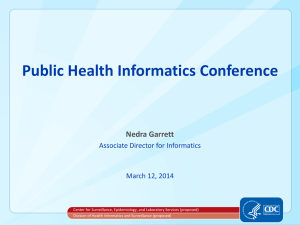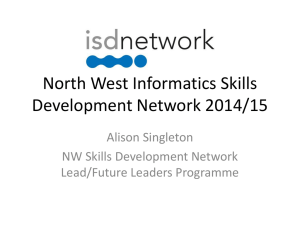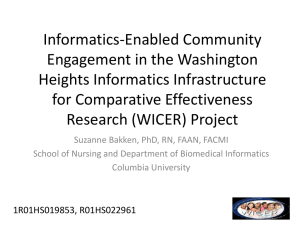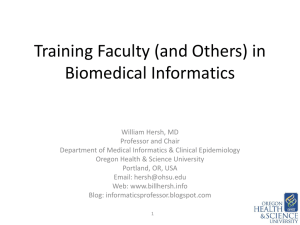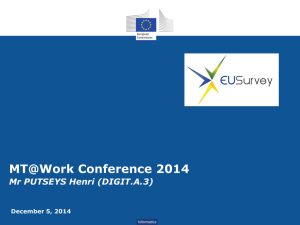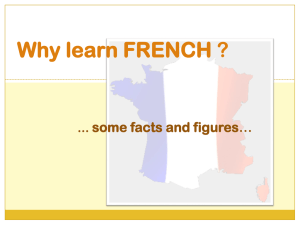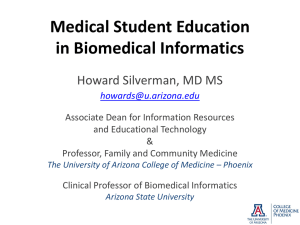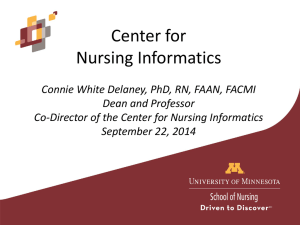Slides
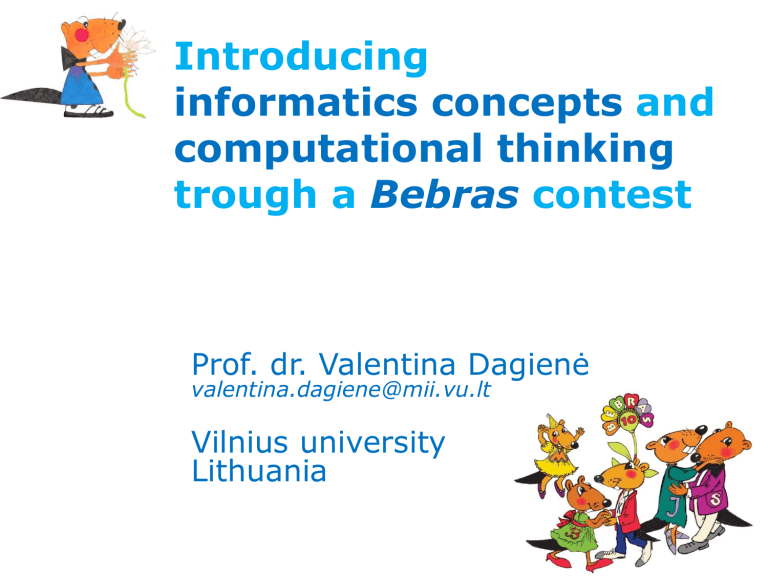
Introducing informatics concepts and computational thinking trough a Bebras contest
Prof. dr. Valentina Dagienė valentina.dagiene@mii.vu.lt
Vilnius university
Lithuania
What is happening in the world of informatics, computing, CS education
•
• strong movement to distinguish informatics , CS, computational thinking, computing… from ICT
• computational thinking has more and more discussed
• attention to STEM
•
• programming (thinking) has become recognized and plays significant (central) role in the process
•
• accompanying effects (unproductive, dangerous) you can learn it in 1 hour; 2 mil customers already did, etc.
• our position (and goal) in the process is different
• it results from our long engagement in
- developing national curriculum for informatics
- running training courses for teachers
- developing programming resources for students
- doing research in informatics education and TEL
What informatics concepts should be included in schools?
• The answer is problematic due to several reasons:
– Informatics is a new and rapidly evolving science.
– the variety of different practical applications of informatics overruns the core theoretical and scientific concepts.
– no common framework , what should be introduced in school from the theory of informatics, and whether it should be introduced at all.
– our goal is to better understand appropriate cognitive demands of education informatics
– from there: help to develop better pedagogy and contribute …
Concepts of Informatics
• are related to „Fundamental Ideas of Computer Science“ that
– are applicable in different areas of informatics
– may be taught on every intellectual level
– will be relevant in the long run
– have meaning in everyday life
• concepts are independent from specific informatics systems
• concepts can be applied in new situations in the future
• concepts are valuable in the long run
• concepts consist of aspects
– algorithms, programming
– symbolic representation
– patterns, structures
– parallelism, synchronization
– iteration, recursion etc.
It is important to think about…
Domains of activities in informatics
A. Solving problems and handling solutions
B. Controlling an agent
direct control
- indirect control = building and handling future behaviours
C. Engaging concepts like… sequence, loops, parameters, procedures…
D. Building and playing with interactive environments
multiple agents
- static scenarios, dynamic scenarios
- engaging concepts like… objects, events, processes…
Bebras task categories
• Information : conception of information, its representation
(symbolic, numerical, graphical), encoding, encrypting.
• Algorithms : action formalization, action description according to certain rules.
• Computer systems and their application : interaction of computer components, development, common principles of program functionality, search engines, etc.
• Structures and patterns : components of discrete mathematics, elements of combinatorics and actions with them.
• Social effect of technologies : cognitive, legal, ethical, cultural, integral aspects of information and communication technologies.
• Informatics and information technology puzzles : logical games, mind maps, used to develop technology-based skills.
International contest on informatics and computer fluency established in 2004 by Lithuania
Main aim: promoting computer science among children and youth aged 8-19
In 2013 the contest had almost 750 000 participants from 30 countries
Participation in 2013
30 countries
Trial
Australia
Cyprus
Egypt
Malaysia
Thailand
S. Korea
USA
New countries
Greece
Iran
Kazakhstan
Mexico
Turkey
Country
Austria
Belgium
Bulgaria
Canada
Czech Rep.
Estonia
Finland
France
Germany
Hungary
Italy
Ireland
Israel
Japan
Latvia
Lithuania
The Netherlands
New Zealand
Poland
Rep. of South Africa
Russia
Serbia
Slovakia
Slovenia
Spain
Sweden
Switzerland
Taiwan
Ukraine
United Kingdom
Particip.
2011
9 171
200
19 280
-
-
4 807
2 045
46 346
155 419
1 911
1 597
-
4 475
-
42 176
-
1 600
893
19 277
11 252
11 945
-
36 382
3 454
Particip.
2012
9 877
848
137
2 400
27 650
4 012
2 197
92 000
186 048
3 200
3 885
-
1 500
3 600
1 336
24 390
12 000
15 578
6 682
49 798
8 120
1 625
7 086
8 100
59 918
-
First
Contest
2013
2012
2013
2008
2011
2011
2012
2010
2012
2008
2013
2006
2011
2005
2004
2005
2013
2005
2007
2012
2012
2011
2008
2005
2010
2011
2006
2011
2009
2013
Particip.
2013
2 008
4 371
1 038
25 909
12 592
217
15 933
1 111
17 584
6230
55 017
12 040
711
1 869
9 733
9 526
86 266
21 473
12 154
565
551
4 229
34 454
3 517
4 423
171 932
206 430
6 246
3 288
3 141
http://www.beverwedstrijd.nl
http://informatik-biber.de
Task oriented contest for school pupils aged 8 to 19.
Goals:
• to develop Computational Thinking
• to stimulate pupils’ interest in informatics and IT
• to encourage pupils to think deeper while using computers and technology
• to inseminate concepts of informatics
Bebras Contest - Participants
Different tasks for 5 age groups:
• Mini 8-9 years
• Benjamin 10-12 years
• Cadet
• Junior
• Senior
13-14 years
15-16 years
17-19 years
Age group
Grades
Mini Benjamin Cadet Junior Senior
1 2 3 4 5 6 7 8 9 10 11 12
Bebras Contest - Tasks
• Pupils have to solve 15-21 tasks within 40-55 min
• Interactive tasks and multiple-choice tasks
• 2-3 minutes per task
• Difficulty levels of tasks: easy, medium and hard
• Performed on computers, usually during school lectures, by using different contest environments
Sponsored by
Bebras Mini-Challenge!
• Bebras Mini-Challenge! allows students to solve one Informatics-based task and compete against time.
• Tasks are parameterised.
• Task concept is changed each week on
Sunday.
• Scores determine who can solve the most number of tasks.
• The contest field is open 24h to all ages of learners.
Learning in Bebras Contest
• Each stated Bebras task involves an aspect of an informatics concept
• Learning by doing
• Learning by exploring
• No theory of a concept
• No names of the concepts are mentioned
• Even advanced concepts possible
• A proper task story can ease a task essentially
• Starting point for further interest
Developing Problem Solving Skills
• Solving Bebras tasks educates in
„Computational Thinking“.
• Computer science (CS) like thinking is done while solving a task.
• Tasks are mostly on CS-related problem solving skills.
• Each task involves a CS concept that needs specific thinking qualities.
Number of contestants distributed by grades in Lithuania in 2013
How successful were boys and girls when solving tasks - the distributions of their scores
How successful were boys and girls when solving tasks - the distributions of their scores
How successful were boys and girls when solving tasks - the distributions of their scores
Task example taken from the Bebras contest 2013
Distribution of solution of the task
“Ice cream machine”
Task example taken from the
Bebras contest 2013
Distribution of solutions of the task
“Visiting friends”
Task example taken from the Bebras contest 2013
Distribution of solutions of the task
“Spinning toy”
Task performance improves with age
Task score normalized to 100. An average score of 100 would mean that all students solved the task correctly.
Influence of Bebras Contest
• On teaching informatics (computing)
– Introduces concepts to pupils
– Encourages exploring
– Gives examples of good tasks
– Stimulates learning some topics of Informatics
• On curriculum
– Sets an international standardization
• On teacher training
– Challenges teachers to deal with new concepts
– Improves deeper understanding of informatics
Attractive Tasks
• are interesting, powerful, surprising, inspiring, ...
• stimulate to think and to learn about some aspects of CS concepts
• offer equal chance for all pupils coming from different countries and different school types
Criteria for a good Bebras task
good tasks … are related to informatics, ICT, or computational thinking allow learning experiences can be solved in 3 minutes do not require specific preknowledge have a difficulty level
(3 levels) are adequate for the age of contestants explanation see task categories learning gives satisfaction and is never boring average time not to check memorized knowledge
1/3 easy solvable with little thinking
1/3 medium more thinking required
1/3 hard for the best
Benjamin: grade 5 to 6, Cadets 7 to 8
Junior: 9 to 10, Senior: 11 to 13
Criteria for a good Bebras task
are independent from any curriculum The Bebras tasks are oriented on the usual ability of pupils of the addressed age groups are independent from specific IT systems have easy understandable problem statements
All system specific terms must be explained within a task easy understandable wording and presentation of the problem and never misleading are presentable at a single screen page no scrolling necessary are solvable at a computer without other hardware, additional software or paper and pencil due to time restrictions and prevention of cheating are politically correct no gender, racial or religious stereotypes
What are different attributes of tasks
IL-06 Data Transmission
(Benjamin easy)
We are in 18th century. Popeye The Sailor Man found a treasure chest on a Caribbean island and wants to send a message to his friends on land. When Popeye eats spinach, he is capable of making different kinds of water waves.
His friends know the meaning of the following signs.
I found the treasure .
I'm waiting on the island hurry
Popeye sends his friends the following message by creating water waves:
What does this message mean?
A.I found the treasure. I'm waiting on the island. Hurry.
This is informatics
To transport information we need a representation (code), a transport medium, a sender and a receiver. Digital
D.I'm waiting on the island. Hurry informatics systems.
EE-03 Bookshelf
(Junior medium)
The librarian wants to order the volumes of an encyclopaedia with as few steps as possible.
For doing one step he takes a volume out of the shelf, shifts some of the remaining ones to left or right and puts the volume in his hand to the new free space.
The following example sorts 5 volumes using just one step:
Now he wants to order the following 9 volumes:
This is computational thinking
A largest increasing subsequence remains untouched in the optimal solution . To find substructures that remain invariant is a key competence of computational thinking.
What is the smallest number of steps to order all 9 volumes?
CH-09 Beaver's log factory (Senior hard)
The beavers have established a site (A) where they do all their log chopping. They want to transport them through a series of canals to the biggest dam ever built (D). Unfortunately the canals allow the transport only of a certain number of logs per minutes (the number at each arrow).
How many logs can reach the dam (D) per minute?
This is informatics
The “maximal flow” in a network with capacities is a typical optimization problem. It can be solved on a computer even for large networks with help of a systematical algorithm, that can efficiently calculate the exact solution.
PISA 2012
NL-12 Wrong hat
(Cadet medium)
The beavers Anna, Brandon, Dave und Emily have in dressing style two rules:
• All four beavers have the hat with their preferred colour.
• None of the beavers prefer the same hat colour as the colour of the shirt
But at the moment all four beavers have the wrong hat colour:
To which beaver belongs the green hat?
A. Anna
B. Brandon
It is informatics
C. Dave
D. Emily
Logic deduction is the basis of computer science. Exclusion of impossible arrangements can lead to the desired solution.
NL-08 Black and white images
(Benjamin)
Images on a computer are divided up into a grid of small dots called pixels.
In a black and white image, each pixel is either black or white. The computer can represent black and white images with numbers, for example:
The first number always gives the number of white pixels, the next number gives the number of black pixels and so on. So the first line consists of 0 white pixels followed by 5 black pixels. The second line consists of 2 white pixels, 1 black pixel and 2 white pixels.
Which letter is represented by the following numbers?
0,1,3,1
0,1,3,1
0,5
0,1,3,1
0,1,3,1
A) B B) U C) H D) E
SK-02 Plates
(Cadet)
A one-handed robot can take one plate from the leftmost pile of plates and place it either to pile number 1 or to pile number 2.
We can program the robot by a sequence consisting of numbers 1 and 2 only. Each number says to which pile the plate should be put.
The robot just now finished executing the following program:
2 1 2 1 1 2 1 and the piles look like this:
How did the piles look like before the program has started?
A B
C D
AT-14 Password machine (JUNIOR)
In the school’s computer lab the beavers have to set new passwords for their accounts.
They are allowed to use lower-case letters, capital letters and the digits from 0 to 9. Each password must have a typical order to be accepted.
A-Z means any capital letter from the alphabet. 0-9 means any digit.
a-z means any lower-case letter from the alphabet.
There are certain rules for the password to be accepted.
In a loop any quantity of letters or digits can be used.
In this loop the beavers are allowed to use zero, one or more capital letters.
An edge means that the beavers have to use
exactly one letter or digit.
This edge demands one lower-case letter.
Which of the following passwords won’t be accepted?
A) 123aNNa B) Peter3ABCd
C) 2010Beaver4EVEr D) bENNOZzz
CH-10 Missing piece
(Senior)
Beaver John has received a secret message.
Unfortunately a part of the message has been destroyed by a spill of red colour.
This case was foreseen and there are additional squares in the message. Each square in the rightmost column (column 6) or the lowest row
(row 6) is coloured such that the number of black squares in a row, respectively in a column is even.
John considers there are sixteen different possible messages. Only two of them make sense to him.
What is a valid pattern of the red piece?
DE-01 Plant life (SENIOR)
The Beaver loves flowers. May be this is the reason why he has invented a simple programming language for visual design based on the idea of plant life.
Each picture starts with a square called a. A visual object can perform three operations: grow(), split() and die().
a.grow(east); a.grow(east) ;
The Beaver loves flowers. May be this is the reason why he has invented a simple programming language for visual design based on the idea of plant life.
Each picture starts with a square called a. A visual object can perform three operations: grow(), split() and die().
b,c = a.split(); c.grow(north); b.die();
Please note, that only an oblong object may execute the split()-Operation producing two shorter Objects of equal size. A square cannot be split.
Beaver wants to write a program that transforms the left image to the right image. Which one could be the first four commands of this program?
A.
a.grow(east); a.grow(east); b,c = a.split(); b.die();
B.
a.grow(north); a.grow(east); a.grow(east); b,c =a.split();
C. a.grow(east); a.grow(east); a.grow (north); a.die();
D. a.grow(east); b,c = a.split(); c.grow(north); c.grow(east);
A pavement ( Junior-Medium )
Peter took a photo of a pavement in front of his house and then created a graph which describes the paving (see pictures).
A point on the graph represents a tile. A line joining two points represents any two tiles bordering.
Later Peter was walking in the town and was photographing pavements. When he returned home he realized that all pavements (except of one) were suitable to fit his graph. Can you recognize which of them was not?
A B C D
Constructive Beaver
Beaver has developed a very simple modeling language. It consists only of two kinds of objects and two possible operations
Which operation sequences would generate this thing?
The operation add(A, B) means: Put A and B side by side and glue B to the right side of A. The operation turn(A) means: turn
A clockwise around 90 degrees.
A
A = add(cylinder, cylinder)
B = turn(A)
C = turn(B)
D = add(C, cube)
B
A = add(cylinder, cylinder)
B = add(A, cube)
C = turn(B)
D = add(C, A)
C
A = add(cube, cube)
B = add(A, cylinder)
C = turn(B)
D = add(C, cylinder)
D
A = add(cube, cylinder)
B = add(A, cylinder)
C = turn(B)
D = add(C, cylinder)
E = add(D, cylinder)
Stack of plates (Benjamin - Medium)
In the restaurant of the Beaver school, there are two different kinds of plates: the high green ones for the small beavers, and the flat brown ones for the big beavers.
One day, due to building activities, there is only room for one stack of plates.
The beaver kids are queuing for their lunch, and the kitchen beavers need to put the plates on the stack in the right order to make the stack match the queue. Example:
In one of the following pairs of plate stacks and beaver queues, there is a mismatch between queue and stack. In which one?
A. C.
B.
D.
Traffic Jam
In the Beaver Den there are some tracks. Because Beavers don't go backwards there are some parallel tracks to give way. Look at the figure. In each cell can be only one beaver.
In which situation a total traffic jam is unavoidable?
Bebras workshops for creating tasks
• 2005 in Balsiai, Pasvalys, Lithuania
• 2006 in Balsiai, Pasvalys, Lithuania
• 2007 in Balsiai, Pasvalys, Lithuania
• 2008 in Torun, Poland
• 2009 in Balsiai, Pasvalys, Lithuania
• 2010 in Dagstuhl, Germany
• 2011 in Druskininkai, Lithuania
• 2012 in Druskininkai, Lithuania
• 2013 in Torun, Poland, June 27 – July 1
• 2014 in Druskininkai, May 28 – June 2
• 2015 in St. Polten, Austria, May 25 – 30
Bebras tasks for transmission of informatics concepts (1)
1 Digital literacy
• basic knowledge and concepts of informatics and computers
• computer literacy, working with applications
• ethical and legal issues, security, history of computing and informatics
2 Programming
• formal description of a solution, process, behaviour, progress
• understanding, analyzing, interpretation and assembling such descriptions
• algorithms, algorithmic thinking
Bebras tasks for transmission of informatics concepts (2)
3 Problem solving
• logical reasoning, justification, argumentation
• puzzles, riddles, problems
• strategies for problem solving
4 Data handling
• representations, coding, patterns, structures
• mathematical basics of informatics, combinatorics
• data and data structures, information and data processing
Kalas, I., Tomcsanyiova, M.: Students’ Attitude to Programming in
Modern Informatics. Informática na Educa-ção: teoria & prática,
Porto Alegre, vol. 12, no. 1, p. 127-135, 2009
Few “commonly agreed” concepts of informatics for schools
• Algorithms and programming
– Decomposed into data, variable, cycle, procedure, object, class, etc.
• Structures and patterns
• Information
• Automata
• Graph theory elements
Informatics concepts at school
Juraj Hromkovic
Informatics concepts at school
Juraj Hromkovic
CSTA K-12 Computer Science Standards
10 fundamental concepts
• Computer organization
• Information systems
• Networks
• Digital representation of information
• Information organization
• Modelling and abstraction
• Algorithmic thinking and programming
• Universality
• Limitations of information technology
• Societal impact of information technology.
Key informatics concepts for schools
Process of integration of informatics concepts in general education
Bebras contest: the challenge of thinking
• To solve the tasks one has to think
• Already learned knowledge is not asked
• Pupils have to find solving strategies
• They have to find and understand structures
• They have to think about different cases
• They have to find arguments for or against given alternatives
Computational Thinking
• Logically organizing and analysing data
• Representing data through abstractions such as models and simulations
• Automating solutions through a series of ordered steps
• Identifying, analysing, and implementing possible solutions with the goal of achieving the most efficient and effective combination of steps and resources
• Generalizing and transferring this problem solving process to a wide variety of problems
• Formulating problems in a way that enables us to use a computer and other tools to help solve them
Computational Thinking: CSTA
• The Computational Thinking Task Force of CSTA suggested an operational definition of CT tailored to the needs of K-12 education containing a characterization of 9 essential CT aspects :
• data collection; data analysis;
• data representation;
• problem decomposition;
• abstraction;
• algorithms & procedures;
• automation; simulation;
• and parallelization.
• CSTA Computational Thinking Task Force. (2011).
Computational thinking teachers resources second edition.
Aspects of Algorithmic Thinking
• Analyse a Problem
• Describe a Problem
• Detect structures and patterns
• Find a solution strategy
• Invent an Algorithm
• Describe an Algorithm
• Analyse an Algorithm
Conclusions
• Focus on fundamental Informatics concepts using different ways – Bebras contest can be one of them
• Bebras contest is established to introduce
Informatics concepts to pupils regardless of whether she or he is taught informatics at school or not
• Learning Informatics should develop young people into ‘ technology designers and creators ’ rather than merely ‘ technology users ’ – a philosophy of creativity and expression rather than mere productivity
• To elaborate modern Informatics curriculum framework
• To elaborate modern Informatics teacher education framework
Thank you!
International Bebras website: bebras.org
